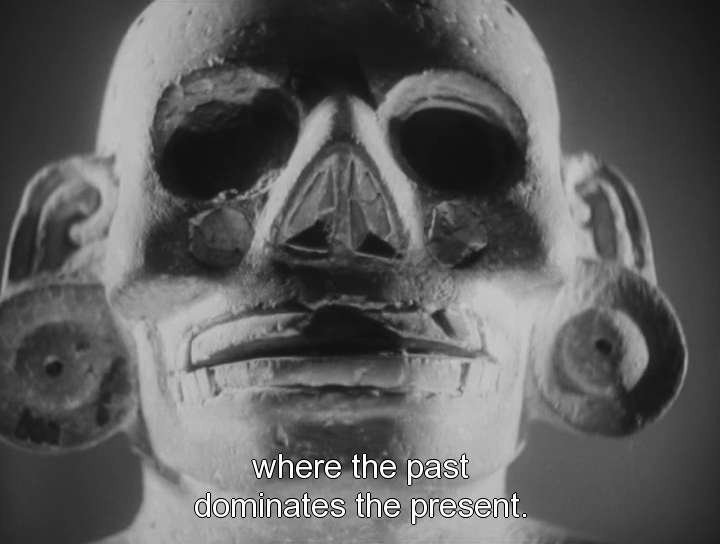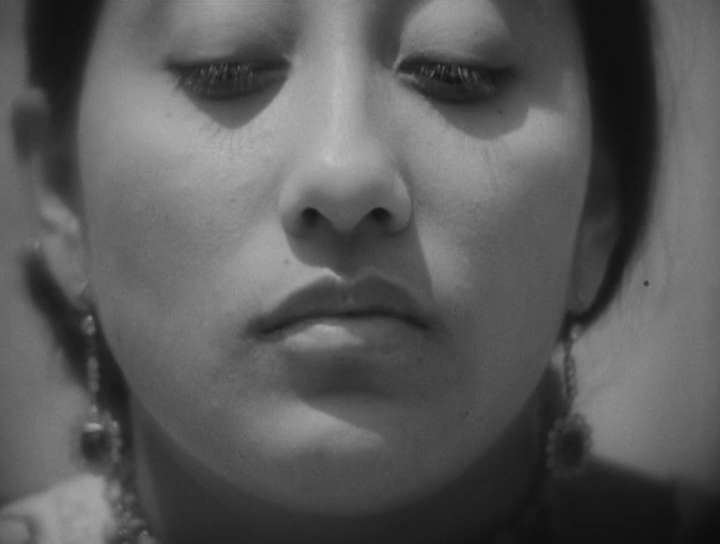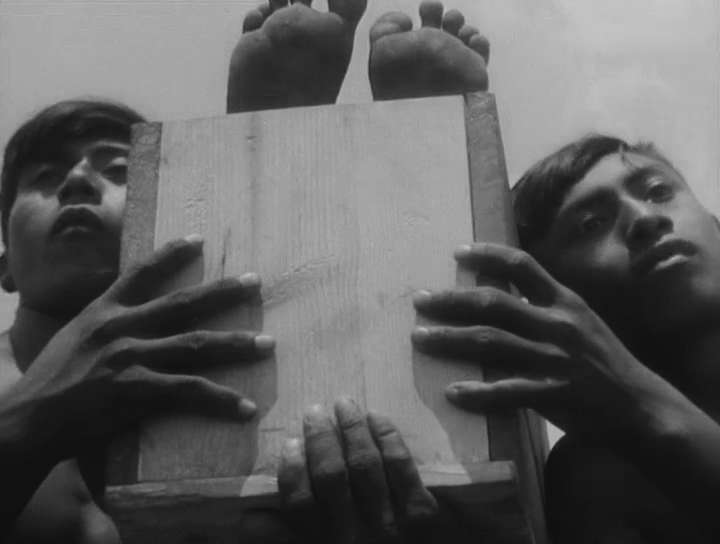
Da zdravstvuyet Meksika! AKA ¡Que viva Mexico!
Having revolutionized film editing through such masterworks of montage as Potemkin and Strike, Soviet director Sergei Eisenstein emigrated west in hopes of testing the capabilities of the American film industry. Quickly ostracized from Hollywood, Eisenstein, Grigory Alexandrov and photographer Eduard Tisse (at the urging of author Upton Sinclair) wandered south of the border where they began filming a highly stylized documentary on the people and volatile social climate of Mexico. Unfortunately, a lack of funds prohibited the film's completion and the famed director was unable to edit the film. In 1979, by referring to Eisenstein's extensive notes and sketches, Alexandrov assembled the most definitive version of the film; as close to Eisenstein's vision as one is ever likely to see.
A blend of the ethnographic, the political, the scenic and the surreal, Qué Viva México! is nothing short of brilliant and remains superior to the legion of films it strongly influenced: Orson Welles' It's All True, Allejandro Jodorowsky's El Topo and the works of Sergio Leone. With sequences devoted to the Eden-like land of Tehuantepec, the savage majesty of the bullfight, the struggles of the noble peasant and the hypnotic imagery of the Day of the Dead, Qué Viva México! is a vivid tapestry of Mexican life which, thanks to Alexandrov's careful restoration, takes its rightful place alongside Eisenstein's other legendary works.
In Old Mexico.
Even though "Thunder Over Mexico," a film which is now at the Rialto, may fall short of what it might have been had its director, Sergei M. Eisenstein, himself supervised the assembling and cutting of the mass of scenes he photographed in Mexico, it is, until the latter stages, a testimonial to its producer's imagination, skill and artistry.
According to authoritative sources, M. Eisenstein, the Soviet producer of "Potemkin" and "Ten Days That Shook the World," photographed no less than 285,000 feet of film in Mexico, and it is dubious whether he could have done much better by the picture if it were to be exhibited at one sitting, for in its present form it is only a little over 7,000 feet. Nevertheless, it has stirred up a great many protests from persons who maintain that Eisenstein's work has been massacred. Sol Lesser is responsible for the arranging and cutting of the scenes as the film stands now. He culled first 40,000 feet from the fifty-four miles of film and then went to work to turn that into a commercial length feature. It is true that the picture is absurdly abrupt in the closing interludes, but for fully three-quarters of its length it snows Eisenstein, the stylst, at his best.
"Thunder Over Mexico" is being presented by Upton Sinclair, who was instrumental in getting the capital for Eisenstein to make the film after the Russian severed his connection with Paramount Publix, because the studio heads of that concern did not see eye to eye with him in the proposed picturization of Theodore Dreiser's "An American Tragedy." As Eisenstein was refused permission to re-enter the United States after he had been working on the picture in Mexico, the 2,850 cans of film were shipped to Hollywood, and it is reported that executives from all the major studios looked at the bewildering mileage of pictures and declared that it was not possible to put the mass into coherent form.
Be that as it may, "Thunder Over Mexico," thanks to Messrs. Sinclair and Lesser, is now here. Its characters are played for the most part by Mexicans who had no experience in acting. Yet, under the tutelage of M. Eisenstein, they acquit themselves with no little distinction. The drama in which they figure concerns the days of twenty-seven years ago, but the actual story is prefaced by glimpses of Aztec ruins on the Anahuac plateau, the Mayan relics on the Yucatan plains and other suggestive views. The director points to the rugged monuments of the Aztecs and compares the profiles with those of the individuals who serve in the narrative.
There are flashes of compelling beauty, skies that are angry and others that smile. Throughout the work there are lovely highlights and deep shadows, virtually all the scenes having been made in the open. It is a story of a peon who accompanies the girl he intends to marry on a visit to his master, the wealthy man who owns the hacienda. The master's daughter is about to celebrate her own engagement. The peon, incidentally named Sebastian, is refused permission to enter his master's home. The girl, Maria, enters alone and in the course of time she is insulted by one of the master's guests. Trouble follows for Sebastian when he resents the insult and it culminates with Sebastian and two of his friends being bound, put into holes in the ground and trampled to death by horses going back and forth.
The climax to the film is horribly realistic. To accentuate the sadistic effect the sole sounds one hears—except for the music accompaniment in this otherwise silent production are the agonized cries of one of the victims.
In one or two scenes M. Eisenstein derides religion, but later the title writer does the reverse, for one gathers that present conditions in Mexico come, in the film, as an answer to a girl's prayer.
At the opening performance of the film on Friday Mr. Sinclair declared that the picture followed Eisenstein's own scenario and that the scenes had been selected in proper proportion to make practicable footage.
The musical accompaniment to the picture was arranged by Dr. Hugo Riesenfeld.
THUNDER OVER MEXICO, an abridgement of the film, "Que Viva Mexico," which was directed by Sergei M. Eisenstein and photographed by Edward Tisse with an anonymous cast of native Mexicans; distributed by Sol Lesser; presented by Upton Sinclair. At the Rialto.
M.H., NY Times, September 25, 1933





http://www.nitroflare.com/view/05BD2A8705C1EFA/QueVivaMexico-Eisenstein.mkv
http://www.nitroflare.com/view/2D7C29AB1C18024/QueVivaMexico-Eisenstein.eng.srt
http://keep2s.cc/file/53594b4ac440b/QueVivaMexico-Eisenstein.mkv
http://keep2s.cc/file/cd8f44e792f3a/QueVivaMexico-Eisenstein.eng.srt
http://rapidgator.net/file/6a34b2933f9d2fcc5424021881d3184e/QueVivaMexico-Eisenstein.mkv.html
http://rapidgator.net/file/5d733ecf841de82cda8ebfe33de2d521/QueVivaMexico-Eisenstein.eng.srt.html
Language:Russian
Subtitles:English (removable srt)